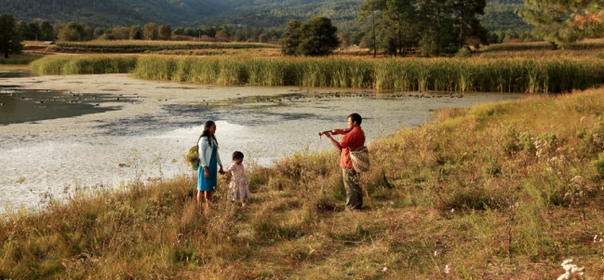PERPETUAL SADNESS or the ravages of neglect
Orianna Calderón of the Guadalajara Talent Press 2014 reviews Jorge Perez Solano's LA TIRISIA

Jorge Perez Solano's LA TIRISIA
Perpetual sadness, abandonment and absence. In LA TIRISIA, Jorge Perez Solano´s second feature film, this disease of the soul that goes all over the mountains, roads, salt-works, homes and bodies that inhabit Zapotitlán, the small region of Mexico where the film takes place. Abandoned region at the same time by the civil and religious authorities but where the omnipresence of the military remembers the context that evokes the structural violence which makes people, especially women, to live a living death, getting sick of sadness, of depression as last and ineffective defense mechanism.
The film is divided into five months, each corresponding to an image of Catholicism predisposes about what will happen in each segment. “May; Mary´s month” stars with a close up of the lead character, Cheba (Adriana Paz), followed by subjective take of a plastic bag stuck in a cactus, when the whole body figure appears, her advanced pregnancy contrasts with the arid landscape. The second inhabitant of Zapotitlán that we get to know is Silvestre (Gustavo Sánchez Parra), as much as fathers to Cheba´s baby -his lover- as he is of his stepdaughter´s. During the first couple of minutes in the film, Cheba gives birth to Tadeo and cuts the umbilical cord aided by his friend Canelita (Noé Hernández), who predicts trouble when her husband returns from the United States. Significantly, this part concludes with the death of the church´s priest. In the month of mothers, the father has died.
It is until the second segment “June, the Holy Heart of Jesus Month", that Silvestre´s stepdaughter talks (before we only see her wandering like a lost soul) to complain to her mother her neglecting ways. There is a highlight at the abundance of flat / reverse shots between these two women that with looks more than words they reproached each other the way they relate to one and other trough motherhood. Silvestre, meanwhile, works in the salt-works and watches the planes crossing the sky, daydreaming about the possibility of going away; frustrated, vents his anger by insulting women around him. In this second part, is the abandonment of the political presence that is explicit; the candidate to the governor’s position does not even get off his truck, considering that is not worth giving his "message of encouragement and hope" to a few tirisientos. (Hopeless beings). Up to half of the third segment, "July, month of the precious blood of Jesus", Carmelo, Cheba's husband, is merely the sound of a cell phone. But with the announcement of his return, Cheba is forced to give her baby to Silvestre to be take care of which simultaneously delegates the responsibility to his wife and stepdaughter, arguing “that is why they have teats”. His young stepdaughter is left then with the responsibility of taking care of two babies. A bird´s eye shoot of a dialogue, medium shoot of Cheba talking to Carmelo about the duration of his stay, is particularly eloquent when right before her eyes she realized he is staying for good. It’s her body that responds and betrays her, the face of distress and milk in her breast.
Then for the fourth segment; "August, pure heart of Mary´s heart", Cheba falls ill with tiricia or hopelessness when forced to cut all ties with Tadeo, throwing his umbilical cord to the river. The close-ups and medium shots of her face deeply saddened interspersed with images of a group of clowns coming to town, clowns reminiscent paraphernalia and promises of happiness of priests and politicians who have abandoned Zapotitlán. By the end of the film, "November, the month of the souls in the purgatory" is redundant with the title of the segment: a close-up of Cheba, her face serving a sentence and a subjective plane where she is looking at the family she has (Carmelo and the two sons she had with him) that forced her to abandon her other son.
Premiered at the 29th Festival Internacional de Cine en Guadalajara LA TIRISIA is a film with a very clear structure, which since its first shoots enters to the contrasting Universe, violent and desolate but beautiful and imposing Zapotitlán. The film photography by Cesar Gutierrez highly stylized, combining general shoots (where the human figure against the immensity of the natural landscape is very small) with close-ups of faces, looks of hopeless characters. The pace of the film is somewhat slow, but this is consistent with the subject. Very subtle but effective way, the Mexican filmmaker denounces the oppressive situation that many low-income women are living in a patriarchal society where they all are victims of structural violence. However, even with such adverse conditions, seems to have little chance for agency; that is shown by scenes like Silvestre´s stepdaughter smiling walking with her baby in tow, or Canelita when he watches a butterfly take off flying. Sparks of life amid of the toil at purgatory.
Technical details: LA TIRISIA (Perpetual Sadness). Written and directed by Jorge Perez Solano. Production: César Gutiérrez Miranda and Jorge Perez Solano. Photo: César Gutiérrez. Cast: Adriana Paz, Gustavo Sánchez Parra, Noé Hernández, Gabriela Cartol. Mexico, 2014.
By Orianna Calderón

